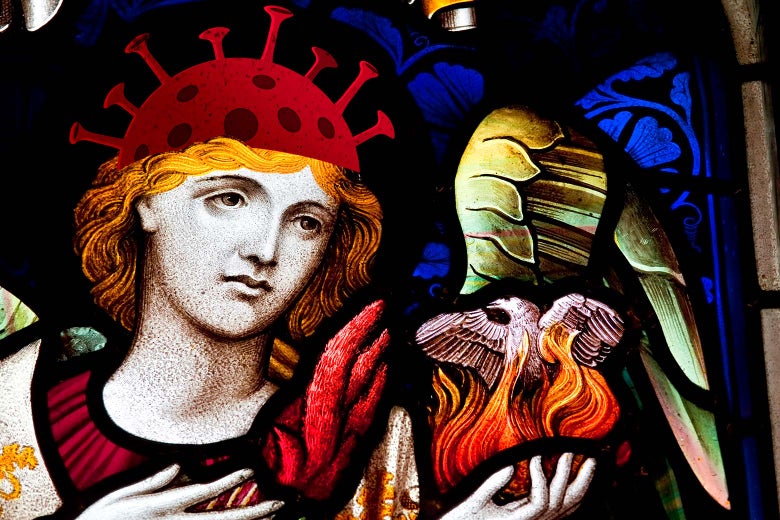
St. Corona keeps getting invoked against the plague and epidemics.
Photo illustration by Slate. Photos by Getty Images Plus.
In uncertain times, it helps to have an oracle and the COVID-19 pandemic is no exception. As millions scramble to adjust to life under quarantine, many have also searched for supernatural guidance. Some have found it in Sylvia Browne, the deathless departed TV psychic, who seemed to predict our current plight in 2008 when she wrote, “In about 2020, a severe, pneumonia-like illness will spread throughout the globe.” Others have waited for a more orthodox spiritual sign. For many people on Twitter, a rash of recent articles about a certain “Saint Corona” resonated. According to those sources, there’s a Catholic saint who’s been waiting around 1,860 years just to help us through this particular crisis. Not only does she share a name with the virus causing the pandemic, but she’s a patroness of plagues and epidemics.
It would be eerie if it were true. There is a St. Corona, but that shouldn’t be particularly surprising. Corona means crown in Latin which is also where the coronavirus gets its name, from the spikes of protein that form a crown around the virus. In Catholicism, the crown is a widely used emblem for martyrdom, particularly for female saints. It’s also specifically mentioned in St. Corona’s hagiography, where she’s always paired with her fellow martyr, St. Victor. According to the 1916 edition of the Roman Martyrology, Corona saw Victor being tortured for his Christian beliefs and had a vision of two crowns falling from the sky, one for him and the other for her. When she announced her vision and declared Victor blessed, she was also condemned. Corona was strapped to two trees and torn apart; Victor was ultimately beheaded.
But this doesn’t explain why St. Corona is getting invoked against the plague and epidemics. This appears to be a recent invention. The first instance that I can find of St. Corona getting cited along with “plague,” “epidemic,” or similar words was on March 11th, when Gloria.tv, a right-wing Catholic version of YouTube, posted an article called “There Is A SAINT CORONA And She Is the Patron Saint Against EPIDEMICS” [sic]. On March 14th, the same information was passed along in the headline of another short article on the traditionalist Society of Saint Pius X’s website and on the more mainstream Catholic site Aleteia. Early in the morning on the 17th, a sentence was added to the Sts. Victor and Corona Wikipedia page that murkily claimed “other sources state her to be a patron saint against plagues and epidemics.” This was later removed, but by then the news had already hit secular media. Esquire repeated the claim later that day and St. Corona, now patroness of plagues, had officially gone mainstream.
All of this raises the question: “How do saints get their patronages, anyway?” The answer is actually: “kind of like this.” Which is to say, a cultural consensus mysteriously emerges and suddenly a new patron saint has been anointed. There’s no formality or ritual for declaring a patron saint for yourself or for a trade organization, cause, or city. In fact, it’s not uncommon for the roles of patron saints to feel like a wry take on their martyrdom. St. Bartholomew, who was flayed alive and is often pictured holding a knife and his limp skin, became the patron saint of butchers and tanners. St. Lawrence, burnt to death on a grill, is the patron saint of cooks. Saints can also switch patronages based on their efficacy in turbulent times. In Naples, even the beloved St. Gennaro was briefly replaced as the city’s patron by St. Anthony, only to be reinstalled after St. Anthony failed to stop a volcanic eruption.
This informal process of declaring a patron saint provides us with lots of options if we’re looking for more established plague saints. Some saints can be relied upon for specific symptoms—the fourteen Holy Helpers are often called on as a kind of crack team against the plague. Among them, St. Barbara is said to help with a fever and St. Blaise can help with throat ailments. Other saints are figures who tended to plague victims and contracted the plague themselves—like St. Aloysius Gonzaga, the young Jesuit who succumbed to Rome’s plague of 1591, and St. Roch, who was miraculously healed by a friendly dog. Other saints only healed plague victims posthumously, the efficacy of their patronage traveling by word of mouth. During the 1656 plague of Naples, mass-produced images of St. Francis Xavier were said to provide miraculous cures when pressed to the sores of victims.
But maybe there’s room for one more patron of plagues, St. Corona. Her feast on May 14th will provide an opportunity to see if she can provide some relief. If she doesn’t, perhaps she’s come to teach us another lesson, one about viral misinformation, which just like a plague, spreads unless we isolate it.
Readers like you make our work possible. Help us continue to provide the reporting, commentary and criticism you won’t find anywhere else.
Join Slate Plusfrom Slate Magazine https://ift.tt/3aePDBq
via IFTTT
沒有留言:
張貼留言